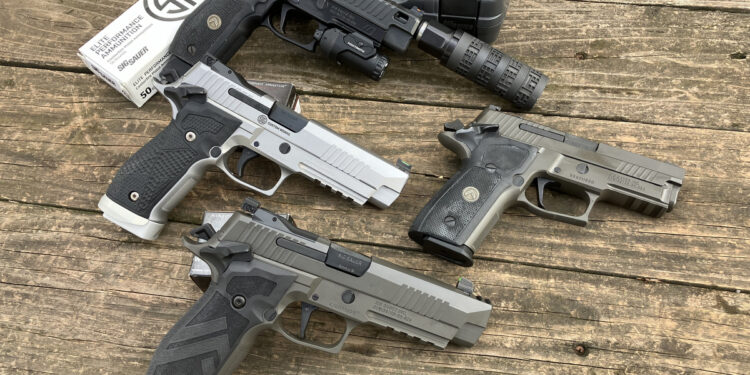By Todd Burgreen
The preponderance of double-stack 9mm 2011s arriving from various manufacturers appears to be heralding a new era of handguns. What was previously thought of as a competition-only application is now going mainstream. Single action triggers mated to a heap of 9mm sitting in a magazine seems a match made in heaven. What if I said SIG Sauer has been offering discerning consumers this ability since the early 2000s with a proven design that requires no magazine tweaking or tuning that the early 2011s were known for?
While SIG has become a standard-bearer for the polymer striker fired genre with its P320 and P365 series, SIG is still representing with the P226/229 family of metal framed, hammer-fired weapons. A little-known SIG Sauer decision made circa 2006 was to offer a single-action-only (SAO) trigger option to shooters with certain models of the P226/229 family. We are going to explore multiple examples of recent SIG handguns featuring single action only triggers—P226Zev, P226XFive Legion, and P229 Legion Compact SAO. Each offer different utility while benefiting from the P226’s proven design that’s combined with single-action-only trigger capability.
SETTING THE STAGE
At the turn of the 20th Century, semi-automatic handguns were typified by hammer-fired steel frames and most likely single-action in that the exposed hammer was cocked rearward when ready to fire. The Mauser 1896 “Broomhandle” and Browning 1911 serve as good examples. In the 1930’s, the double-action/single-action (DA/SA) hammer fired handgun genre arrived in the form of the German P38. Its emergence was just as revolutionary as the polymer, striker-fired Glock’s arrival 50 years later. Yes, other examples existed before each; however, both are recognized as the most successful, establishing the handgun genre to follow. The rise of DA/SA designs and polymer striker-fired handguns surely took away the preeminent position of the “cocked & locked” pistol. This is for a variety of reasons stretching from manufacturing procedures, the perception of added safety, and other reasons.
While there’s no doubting the popularity and staying power of DA/SA and polymer striker-fired weapons, hammer-fired SAO “cocked and locked” handguns have not faded quietly into the sunset. In fact, the case can be made that the popularity of this format is actually flourishing.
HISTORY
Before we get into the details, here’s a little background on the P226 family. The SIG P226 was spawned from the P220. P220 design work started in the late 1960s due to the Swiss wanting a less expensive to manufacture sidearm in lieu of the P210. The P220 entered Swiss service in 1975. Many of the innovative features introduced with the P220 family still prevail today, including on other manufacturer’s weapons.
A great example of this is how SIG modified Browning’s locked breech short recoil design. Instead of slots in the hood of the slide interacting with locking rings on top of the barrel, SIG utilized the forward edge of the chamber locking into the ejection port. This removed complex machining operations from the production process. The De-cocking lever, automatic firing pin safety, pinned breechblock in the steel slide are other examples of the P220 perfecting these concepts.
The P226 reflected SIG’s quest to generate an entry for the early 1980’s U.S. XM9 Joint Service Pistol trials conducted to find a replacement for the venerable but aged M1911A1. The P226 was modified from the P220 to accept double column magazines. When the dust settled after years of testing and evaluation, only the Beretta 92F submission and the SIG P226 satisfactorily completed the trials. As most readers already know, the P226 was not chosen to replace the M1911A1. The Beretta 92F was given the nod for a variety of factors outside the scope of the article. The P226 test performance impressed, thus gaining the attention of various military units, many with elite status, and law enforcement agencies in the U.S. and around the world. The U.S. Navy SEALs were the preeminent unit on this list of adopters. Early on, it was evident that the P226’s reliability, accuracy, safety, and capacity set it apart from its handgun peers.
P226 ZEV: MASTERFUL COLLABORATION
Unlike other manufactures who often forget about their civilian customers after getting a taste of military contracts, SIG’s leadership team keeps the hammer down with both current production and by offering new items based on feedback from its customers. SIG has no problem teaming up with other firms to create unique, enhanced versions of existing SIG products. The P226 Zev Technologies collaboration stands as an excellent example.
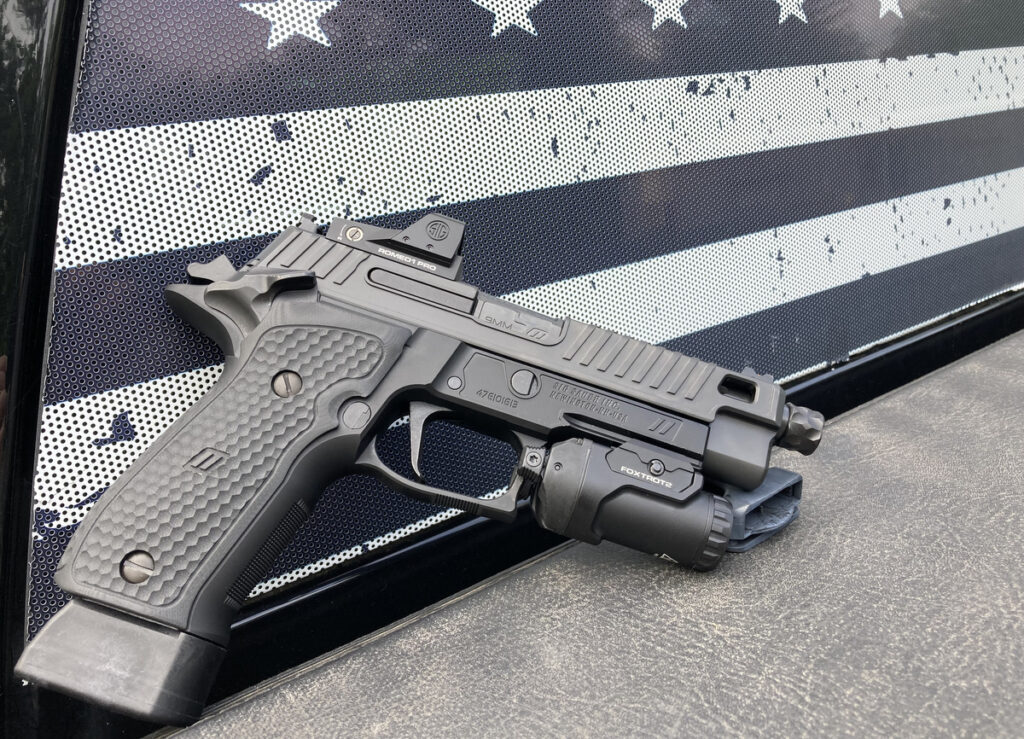
The P226 Zev is more than just a P226 with Zev’s aesthetic flourishes. Zev and SIG created a P226 that pushes the envelope. Immediately, the SAO trigger caught my attention as I’ve never been fond of DA/SA hammer-fired trigger characteristics. Distinctive texturing found on the Nitron-coated stainless slide, hard-coat anodized alloy frame with undercut trigger guard and extended beavertail, Zev-pattern hexagonal textured Hogue G10 grips, and a threaded dimpled barrel create a unique offering.
The P226 Zev offers users the best of the P226 design with a preferred single action trigger. Icing on the cake is the flat style trigger shoe. This offers a 90-degree break that’s less likely to pull the sights to the right or left as the trigger is pulled. I have come to prefer flat triggers based on experiences with SIG’s P226 brethren—P320s and P365s. Ambidextrous manual safeties are present on the P226 Zev in lieu of the de-cocking lever usually found on the standard P226.

Red dots are becoming standard equipment on handguns. Manufacturers have caught up to the red dot revolution with factory-equipped red dot handguns taking over from custom milled slides that dominated early red dot configurations. The P226 Zev arrives with a SIG ROMEO1 PRO reflex optic installed. A 4.9-inch, textured Zev Tech ½- 28 threaded barrel with protector protrudes from the slide. A SIG MODX-9 suppressor was quickly teamed up with the P226 Zev. This can features the newest innovation in suppressor technology with its modular, 3D-printed, segmented titanium baffle stack.

P229 LEGION COMPACT SAO: COMPACT WITHOUT COMPROMISE
SIG realized that a more compact P226 design would help them attract even more consumers, especially considering the expanding concealed carry laws spreading across the majority of U.S. states at the time. Thus, the P229 was born. The SIG P229 Legion Compact SAO is a compact variant of the classic P226 model. The Legion designation carries extra weight in SIG world. Legion nomenclature indicates factory custom shop upgrades based on feedback from SIG Sauer’s elite professional clients around the world. A Legion weapon is intended for customers who rigorously use their gear.
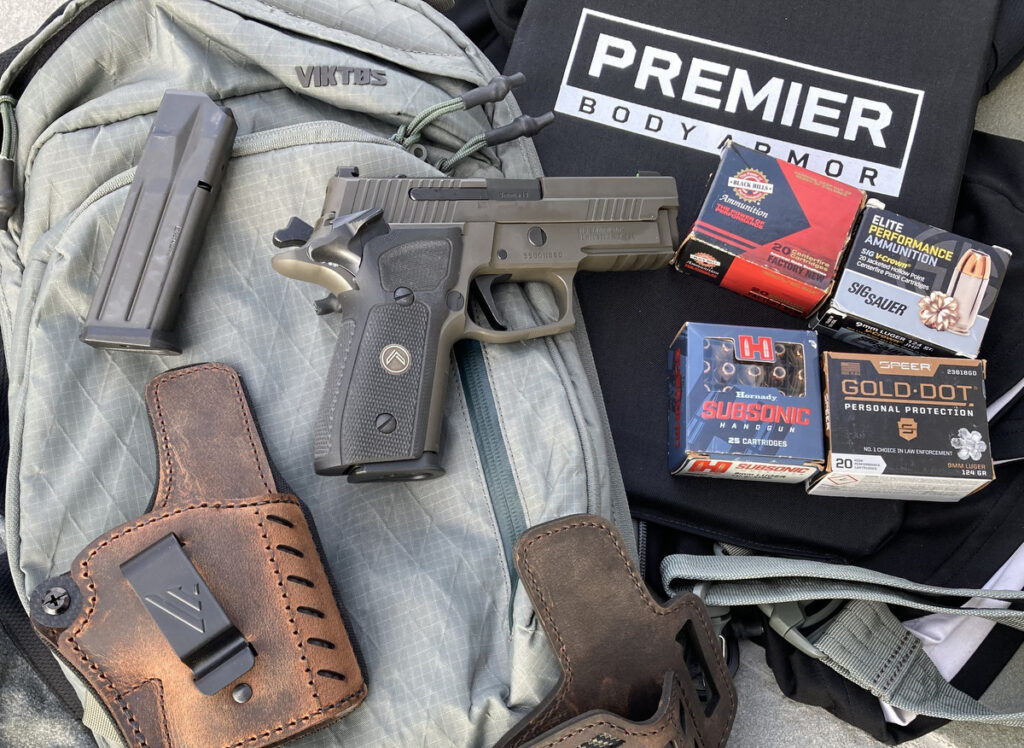
What sets the P229 Legion Compact SAO apart from its P229 stable mates? First, is the Cerakote Elite Legion gray coating covering the stainless-steel slide and aluminum frame. This is not merely idle window dressing; the coating improves durability. Custom G-10 grips with a Legion medallion are also present. The SAO trigger is what focused my attention on the P229 Legion Compact SAO. SIG XRay3 day/night iron sights arrive on the P229 Legion Compact SAO. Don’t worry, the slide is factory milled if user wants to mount a red dot compatible with the SIG PRO or Leupold DeltaPoint Pro footprint. Ambidextrous manual safeties are present on the P229 Legion Compact SAO.
The P229 Legion Compact’s compact profile makes it ideal for concealed carry, especially with inside-the-waistband carry techniques. Someone who is a practitioner of concealed carry quickly realizes that length, grip size, overall weight, and width of a pistol are the key defining parameters for discrete carry handguns.

While the safety lever is located within natural thumb swipe distance, the slide lock sits further toward the rear of the frame compared to other weapons. This all but eliminates the chance of unintentionally engaging the slide lock during strings of fire, as can happen if shooters rest their thumb on the lever with other designs. Another nod to the P229 Legion Compact SAO’s more modern design versus the 1911 is the safety’s ability to stay engaged while manipulating the slide.
The P229 Legion Compact features a contoured, reduced-profile beavertail allowing better hand placement on the frame while limiting concern from printing through cover garments. The beavertail’s protrusion from the frame guides one’s hand to the optimum grip position during the draw stroke and aids in recoil management. More aggressive front strap checkering and additional checkering under the trigger guard enhance grip purchase. An undercut has been applied below the trigger guard, allowing for a higher grip and more control when firing, especially during rapid shot strings.
The P229 Legion Compact’s shorter barrel/slide provides an optimal mix of sight radius, concealment, balance, and reliability. The SIG XRay3 day/night irons compliment the P229 Legion Compact’s intended role as a concealed carry weapon. The P229 Legion Compact SAO’s 3.9-inch, cold hammer-forged barrel and short reset, single-action trigger combined with near perfect lock-up in the stainless-steel slide ensure maximum reliability and accuracy. The SIG single-action trigger pull measures 3.5 to 4 lbs. The aluminum frame features a Picatinny rail dust cover for tactical versatility in the way of lights and laser target designators.
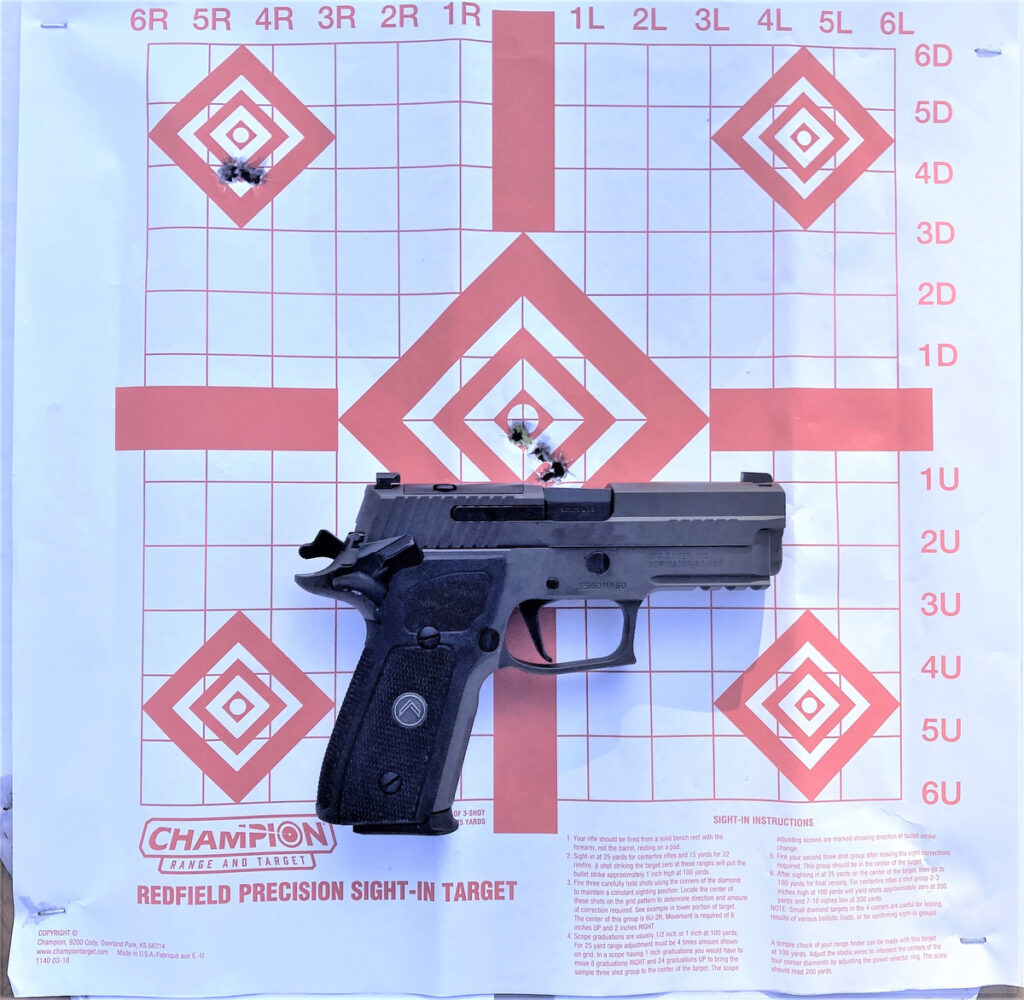
P226 XFIVE LEGION: MATCH MASTER NOW MADE IN AMERICA
Even with their current, preeminent position, SIG has no problem expanding its product line by offering weapons that many considered unobtainable. A recent entry into this category has pistol aficionados sitting up and taking notice—the P226 XFIVE is now made here in the U.S. in the SIG Custom Works shop. Previous P226 XFIVE’s were Teutonic offerings from the German-based SIG MasterShop. These were discontinued in 2012. SIG recently decided to expand on the P226XFIVE by offering a Legion version.

Whereas the P226XFIVE has the competition and target crowd as its focus, the P226XFIVE Legion is more utilitarian with its setup. Yes, if you want to relentlessly punch steel during a match, the P226 XFIVE Legion will accommodate. However, the presence of a slide-integrated expansion chamber, suppressor-height XRAY3 adjustable sights, and subdued Legion Cerakote Gray finish indicate a this model was meant for general, defensive use. It is not hard to fathom why some may consider the P226 XFIVE Legion applicable to personal defense work. Under the rear sight plate, SIG milled the slide to accept red dots with a SIG ROMEO PRO or Leupold DeltaPoint Pro footprint.
The XFIVE Legion’s fully adjustable AX3 SAO trigger is a key component in the XFIVE equation. The XFIVE Legion’s trigger is adjustable for pull weight, over-travel, and length-of-pull. The XFIVE Legion’s trigger is a flat faced as described with the P229 Legion. The XFIVE trigger characteristics aid in rapid target engagement with a trigger pull just over 3 pounds, out of the box.

The XFIVE Legion’s longer slide and barrel combo (when compared to a standard P226) contributes more mass, aiding in increased muzzle control for double taps or longer strings of fire. The pistol’s ergonomics combine with the slide’s smooth tracking during recoil and manageable 9mm muzzle signature to present a very stable sight picture, no matter how many or how fast rounds are fired.
SIG uses the term “integrated expansion chamber” instead of “compensator” in its P226 XFIVE Legion literature. This is a nod to the fact that the 4.4-inch barrel stops short of the slots in the slide. Whereas compensators usually list 30 to 35% recoil/muzzle rise reduction, the integrated expansion chamber provides less than this. Subjectively, it seems like a 10 to 20% effectiveness listing. There’s no need to debate the finer points of compensator effectiveness. Any advantage gained by their use is beneficial. The integrated expansion chamber design with the P226 XFIVE Legion means it can never come loose and requires no extra steps for field stripping due to its integrated construction in the slide.

FINAL THOUGHTS
Each one of the SIG pistols discussed above have been used extensively for extended time frame. All have proved capable of firing groups into one jagged hole at 10 yards with multiple loads. The P226 Zev’s threaded barrel, ROMEO1PRO optic, and single-action trigger allow a user a range of options related to the pistol’s intended role. Combining SIG’s MODX-9 suppressor to the pistol expands this line of thinking. The P226 Zev occupies the role of nightstand weapon with aplomb.
The P229 Legion Compact SAO often accompanies me in a personal defense capacity. Numerous holsters are available, facilitating a multitude of IWB or belt carry options. Comparison of the P229 Legion Compact to the Commander-size 1911or Glock 19 should quell the concerns of anyone thinking the SIG is too large to carry. The SIG P229 Legion Compact SAO is ideal for anyone wanting to capitalize on the SIG reputation for out-of-the-box reliability and accuracy combined with single-action trigger for the utmost control and precise shot placement.
The P226 XFIVE Legion is the newest member of the SIG tribe we have discussed. All will appreciate what the P226 XFIVE Legion offers in terms of accuracy, reliability, handling, and capacity. The P226 XFIVE’s uncanny accuracy will get everyone’s attention. The P226 XFIVE-series now being U.S.-made increases availability and creates a more palatable price for the boutique offering.

While it’s hard to quantify the “feel” of a pistol in the hand, the mystique of a well-put-together single-action semi-automatic handgun is hard to deny in our current polymer striker-fired age. A trigger that arrives featuring minimal to no creep, limited travel and reset, and a break like the proverbial glass rod is hard to resist. All of these things become magnified as knowledge and skills are gained in the quest to run a handgun with ruthless efficiency—albeit in a tactical, duty, competition, or personal defense role.
Lastly, do not underestimate the ability to configure these guns into condition one, cocked and locked carry, which Americans are intimately familiar with thanks to the iconic 1911 design. The 1911’s enduring appeal with the American shooter goes beyond what many can fathom. The resultant attraction of this surely has an effect on the U.S. consumer.
Does nostalgia play a role in the rebirth of hammer-fired SAO only handguns? Hell, yeah it does. SIG has you covered.

| Make: | SIG Sauer |
| Model: | P226 Zev |
| Caliber: | 9mm |
| Weight (empty): | 34.1 oz. |
| Overall Length: | 8.6 in. |
| Barrel | 4.9 in. |
| Magazine Capacity | 15-round |
| MSRP: | $2099 |
| URL: | sigsauer.com |
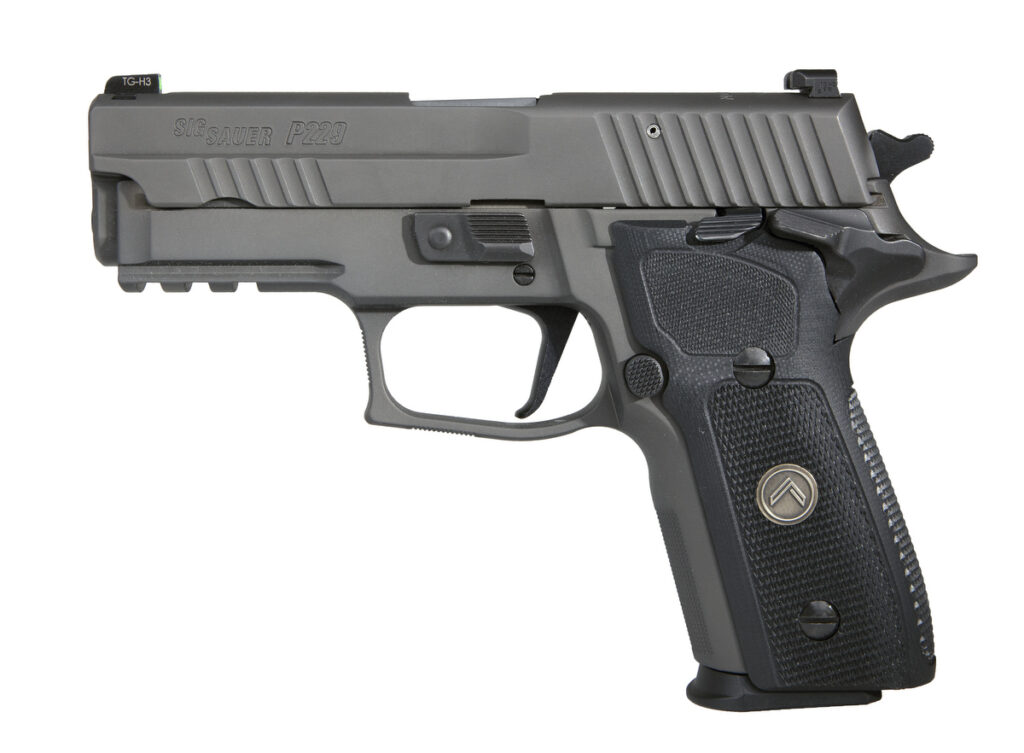
| Make: | SIG Sauer |
| Model: | P229 Legion COMPACT SAO |
| Caliber: | 9mm |
| Weight (empty): | 31.7 oz. |
| Overall Length: | 7.4 in. |
| Barrel | 3.9 in. |
| Magazine Capacity | 15-round |
| MSRP: | $1413 |
| More: | sigsauer.com |

| Make: | SIG Sauer |
| Model: | P226 XFIVE Legion |
| Caliber: | 9mm |
| Weight (empty): | 42.4 oz. |
| Overall Length: | 8.6 in. |
| Barrel | 4.4 in. |
| Magazine Capacity | 20-round |
| MSRP: | $2399 |
| More: | sigsauer.com |



